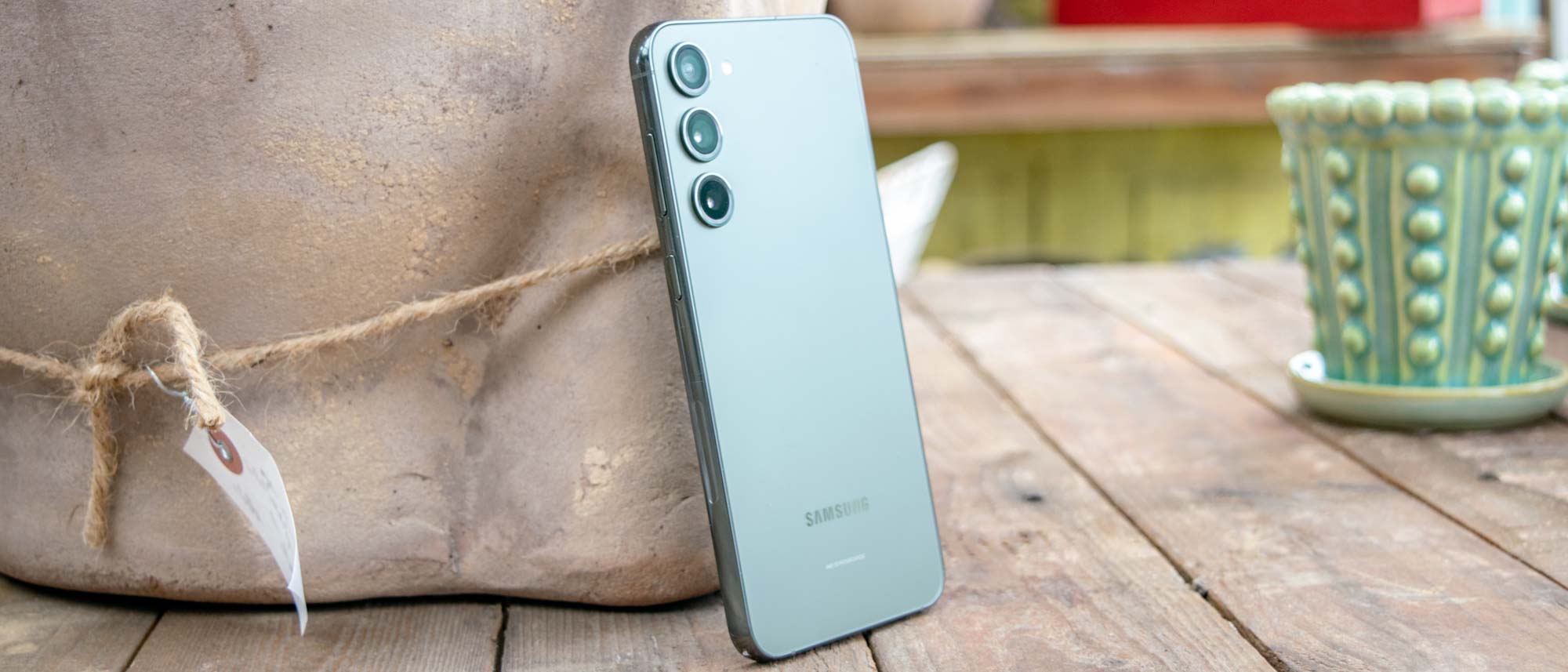Tom's Guide Verdict
The Galaxy S23 Plus feels eerily familiar. Fortunately, it has incredible performance, improved camera software and much better battery life than its predecessor. The display is top-notch, too.
Pros
- +
Much better battery life
- +
Beautiful, bright display
- +
Stellar performance
- +
Good cameras
- +
Great update policy
Cons
- -
Mostly iterative upgrades again
- -
$999 is still expensive
Why you can trust Tom's Guide
Price: Starting at $999
Android version: 13, One UI 5.1
Display: 6.6-inch Super AMOLED (2340 x 1080)
Refresh rate: 48-120Hz
CPU: Snapdragon 8 Gen 2 for Galaxy
RAM: 8GB
Storage / Expandable: 256GB, 512GB / No
Rear cameras: 50MP (f/1.8) main, 12MP (f/2.2) ultrawide, 10MP (f/2.4) 3x telephoto
Front camera: 12MP (f/2.2)
Battery: 4,700 mAh
Battery life (hrs:min): 11:24 (adaptive)
Charging: 45W wired, 15W wireless, 4.5W reverse
Size: 6.2 x 3 x 0.3 inches (157.8 x 76.2 x 7.6 mm)
Weight: 6.9 ounces (196 g)
Colors: Phantom Black, Cream, Lavender, Green
It’s hard not to pick up the Samsung Galaxy S23 Plus and not have a case of Galaxy S23 Ultra envy, not to mention some semblance of deja vu. There’s no headline-grabbing 200MP camera, built-in S Pen or crazy 100x Space Zoom. The S23 Plus feels more iteration than innovation at first glance, much like the Galaxy S22 Plus before it.
If, however, you’re looking for a flagship phone for less than $1,000, the Galaxy S23 Plus makes a very good argument for belonging in your pocket.
I’ve spent the last several days thoroughly testing the Galaxy S23 Plus, and there are some real standout improvements here. The display is brighter and among the best you’ll find on an Android phone. The battery life is longer. And the Snapdragon 8 Gen 2 for Galaxy chip beats the iPhone 14 Pro on graphics performance. Best of all, the Galaxy S23 Plus surpasses the iPhone 14 Pro in my head-to-head camera testing.
There are better Android values out there, including the OnePlus 11 and Pixel 7 Pro, but as you’ll see in my Galaxy S23 Plus review, this flagship is one of the best Android phones around.
Samsung Galaxy S23 Plus review: Price and availability
The Galaxy S23 Plus launched to general availability on February 17 with a starting price of $999. That nets you 256GB of storage, a Snapdragon 8 Gen 2 for Galaxy chipset, and a triple camera setup with a new 12MP front selfie cam. You can also get the phone in a 512GB flavor.
Joined by the Galaxy S23 and Galaxy S23 Ultra, the Galaxy S23 Plus sits right in the middle of the other two models. It’s a larger Galaxy S23 with a bigger battery, twice the starting storage capacity, and much faster 45W wired charging. The 6.6-inch Super AMOLED display has the same 48-120Hz refresh rate and FHD+ resolution. It also shares the same rear and front cameras as the Galaxy S23.
For availability, you can pick up the Galaxy S23 Plus from most carriers and electronics retailers, including Samsung’s own online store. You might find good trade-in values on your old device, so be sure to check out our best Galaxy S23 deals page to make sure you save the most money possible.
Get instant access to breaking news, the hottest reviews, great deals and helpful tips.
Samsung Galaxy S23 Plus review: Design
Samsung kept a familiar design for the Galaxy S23 Plus, which, from the front, looks indistinguishable from the Galaxy S22 Plus. On the back, things appear a little different thanks to the new camera module layout.
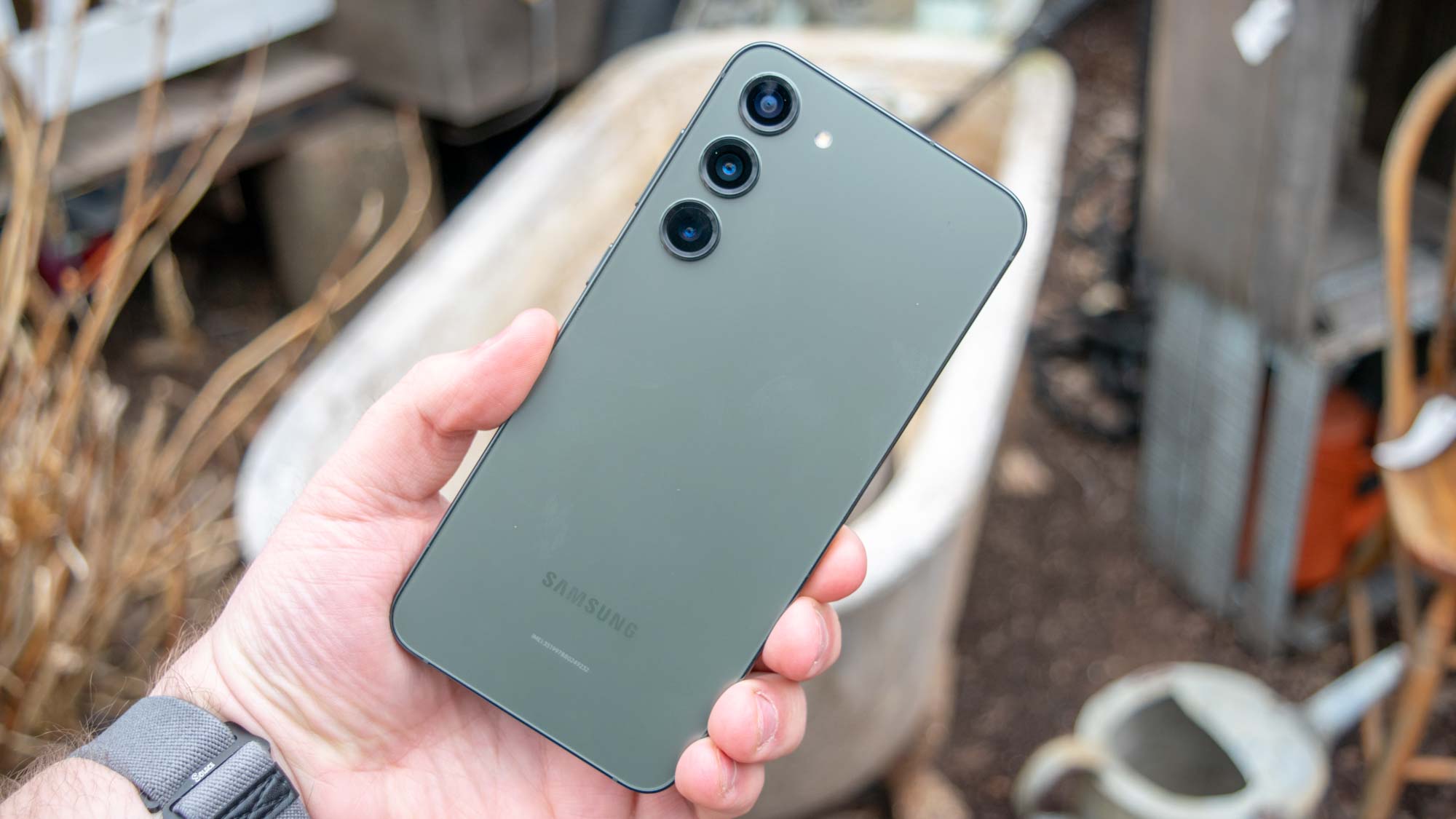
Gone is the contour cut design introduced on the Galaxy S21 with individually stacked lenses replacing it. It looks akin to the Galaxy S23 Ultra, minus the second telephoto camera and laser autofocus. I welcome this shift since it adds some cohesion among the Galaxy S23 series.
Immediately upon picking it up, I thought the Galaxy S23 Plus felt extremely well-built. It’s solid with a comfortable heft at 6.9 ounces (196 grams). I appreciate its sturdiness, which inspires a lot of confidence that it would survive an accidental drop.
Part of that comes from the Galaxy S23 Plus’ use of the new Gorilla Glass Victus 2, which offers more durability for the screen. The Armor Aluminum frame adds some structure while the back also sits underneath Gorilla Glass Victus 2. The final piece of the puzzle is the IP68 rating, meaning that the Galaxy S23 Plus can survive up to 1.5 meters underwater for 30 minutes.
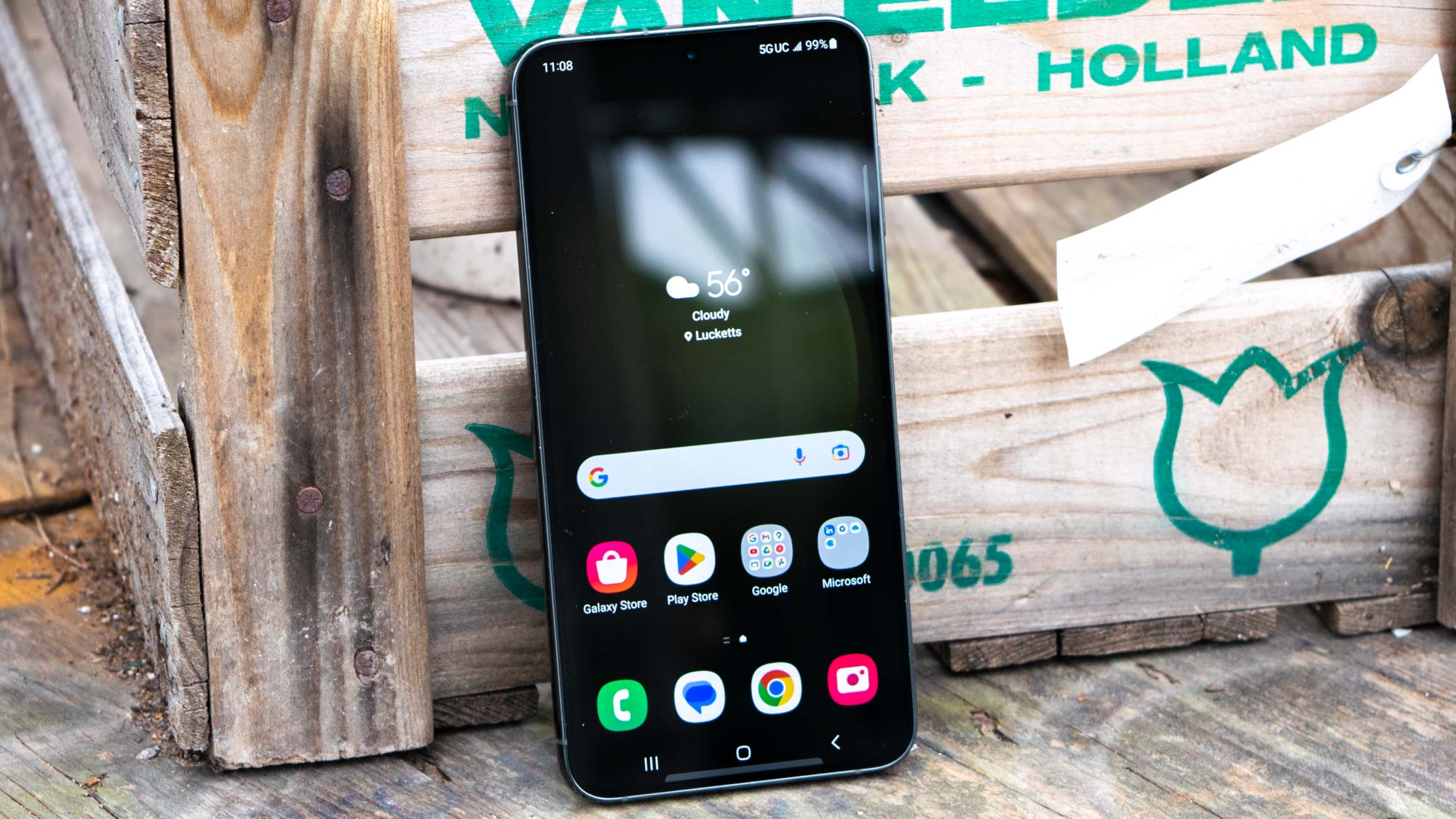
In short, the Galaxy S23 Plus is, on paper, one of the most durable phones you can buy today.
Samsung streamlined the color options this year, keeping them the same across all three Galaxy S23 models. That means the Galaxy S23 Plus comes in Phantom Black, Cream, Lavender, and Green, the latter of which I received for review. I’m quite partial to the dark forest vibe, similar to the iPhone 11 Pro. It has a clean and sophisticated look.
Samsung Galaxy S23 Plus review: Display
As with Galaxy S devices in the past, the display makes the Galaxy S23 Plus truly stand out from its Android competition. Featuring a max rated brightness of 1,750 nits (up from 1,300 nits on the Galaxy S22 Plus), the latest Galaxy middle child’s screen knocked my socks off.
| Galaxy S23 Plus | iPhone 14 Pro | Pixel 7 Pro | |
| Screen size | 6.6-inch Super AMOLED | 6.1-inch OLED | 6.7-inch OLED |
| sRGB (%) | 204 (Vivid) / 117 (Natural) | 120 | 105 |
| DCI-P3 (%) | 148 (Vivid) / 83 (Natural) | 85 | 75 |
| Delta-E | 0.33 (Vivid) / 0.23 (Natural) | 0.25 | 0.28 |
| Peak brightness (nits) | 1,345 | 1,448 | 927 |
As you can see, it’s a great display in our benchmarks. Its natural setting bests the Pixel 7 Pro and falls with a standard margin of error with the iPhone 14 Pro. Interestingly enough, we measured the iPhone as brighter than the Galaxy S23 Plus by a full 103 nits.
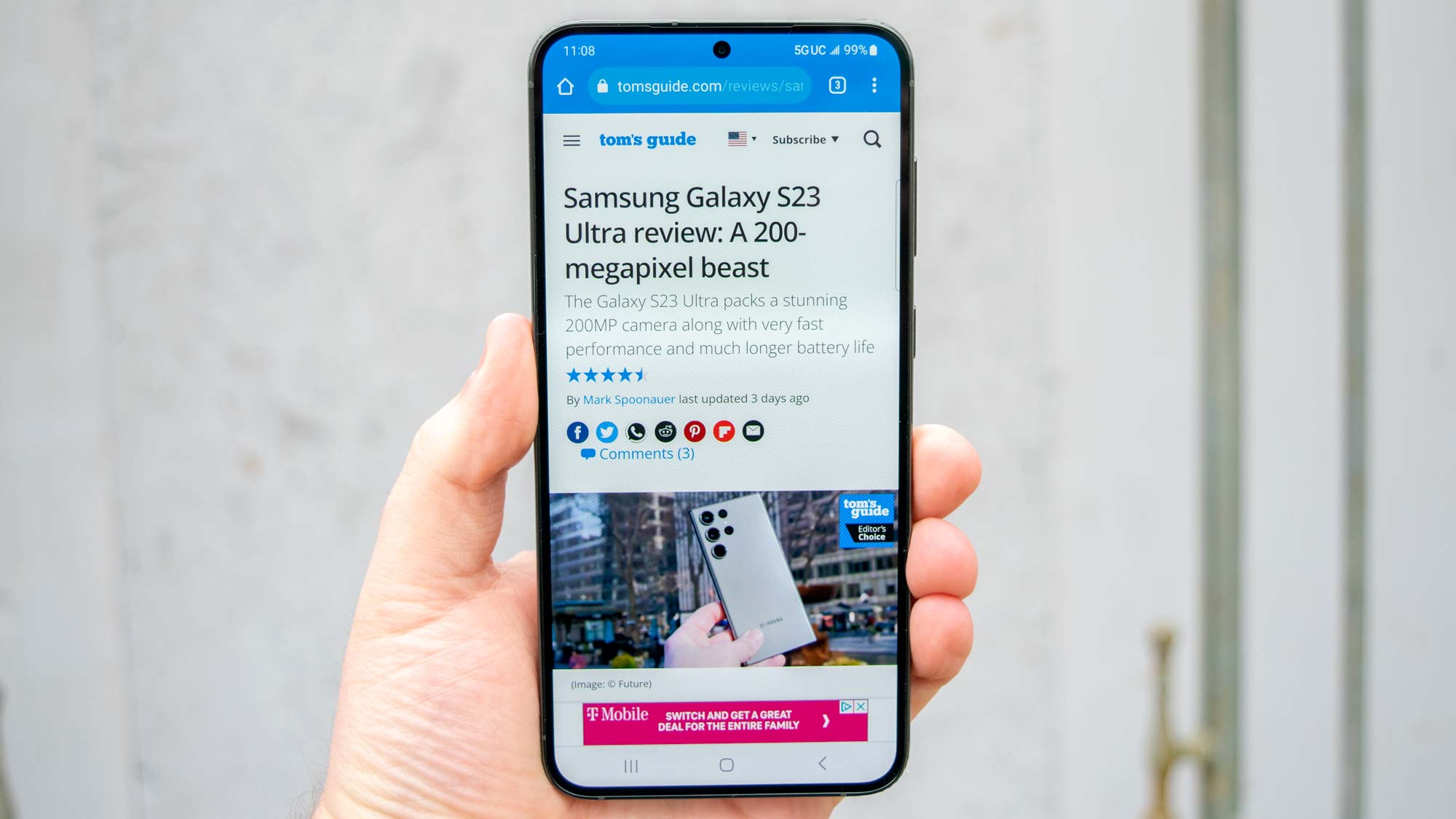
However, Samsung proved more color accurate with its Delta-E score of 0.23 — where zero is perfect — in the Natural mode versus the iPhone 14 Pro’s 0.25. If you opt for the default Vivid setting, you’ll enjoy some vibrant colors, as evidenced by the performance in the sRGB and DCI-P3 gamuts.
At 6.6 inches, the Galaxy S23 Plus strikes a nice balance between the smaller Galaxy S23 (6.1 inches) and the massive Galaxy S23 Ultra (6.8 inches). My biggest disappointment with the display, however, comes down to its refresh rate.

Sure, it can ramp up to 120Hz for the kind of smoothness we expect from flagship smartphones nowadays, but it can only clock down to 48Hz. Other phones like the OnePlus 11 can downclock to 1Hz for added power efficiency. Even the Pixel 7 Pro supports a range of 10-120Hz. While the Galaxy S23 Plus does sport much better battery life than its predecessors, I think a lower range could have improved things even more.
To test a display, my favorite thing to do during a smartphone review is to watch my favorite scenes from Blade Runner 2049 and play Genshin Impact.
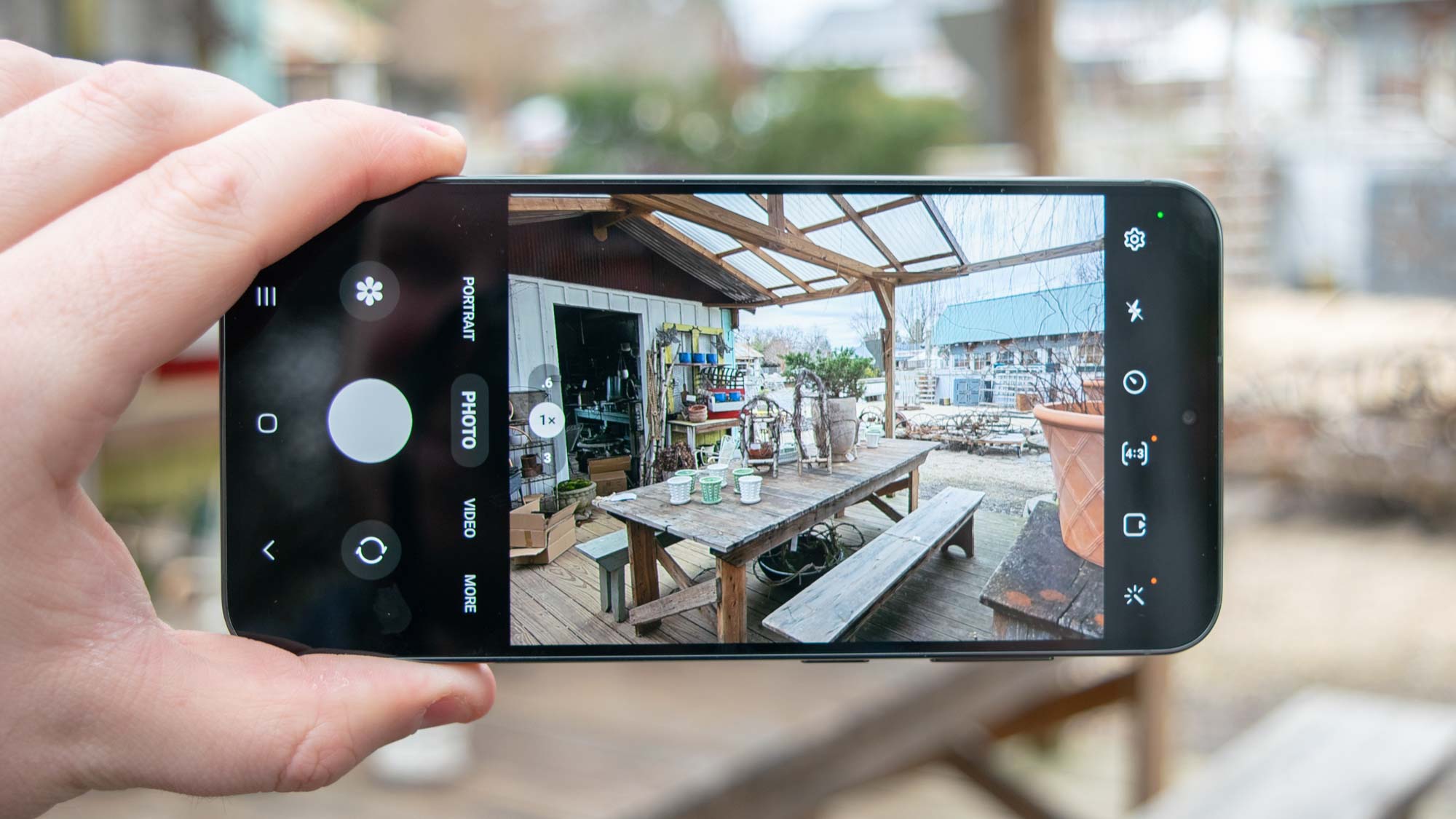
For the former, the film has the typical bright neons of a dystopian cyberpunk future, but then it radically shifts to the harsh orange tones of an abandoned wasteland. The Galaxy S23 Plus handled both elements exceedingly well, especially in the Vivid mode. The neons stunned me, as did the orange and darker parts throughout the rest of the movie.
Genhin Impact uses a supersaturated anime-style aesthetic that shines on the Galaxy S23 Plus. The scenery, particle effects, and character models all look fantastic. When combined with the phone’s best-in-class gaming performance, which we’ll get to in a minute, the Galaxy S23 Plus is one of the best places to play this game.
Samsung Galaxy S23 Plus review: Cameras
The Galaxy S23 Plus features the same rear cameras as the Galaxy S22 Plus, namely a 50MP main sensor with a 12MP ultrawide and 10MP telephoto (3x optical zoom) alongside it. The upgrade comes in the form of the 12MP front camera, which is a bump from last year’s 10MP.
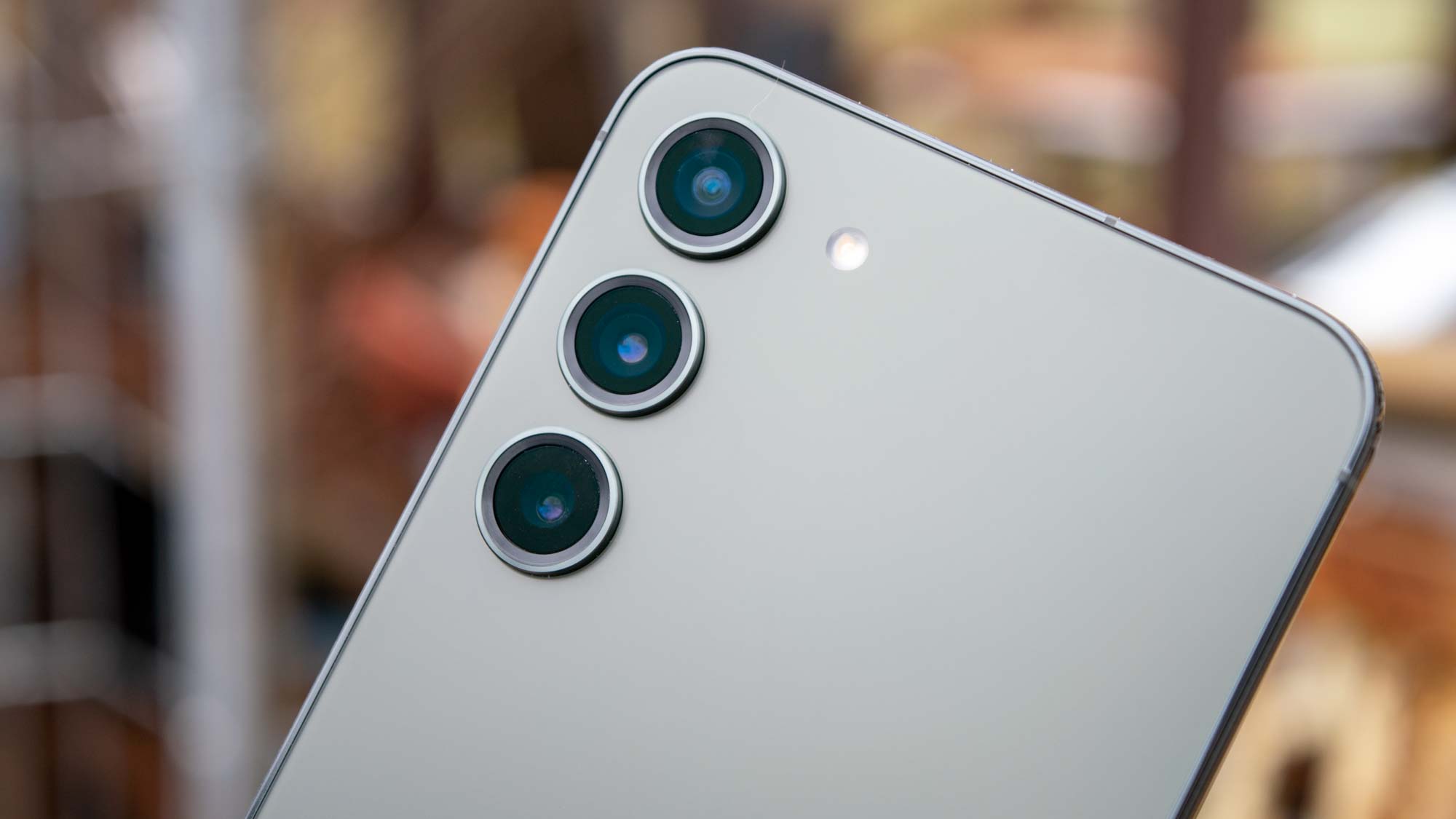
I brought out the iPhone 14 Pro for this camera test, which costs the same as the Galaxy S23 Plus.
| Galaxy S23 Plus | iPhone 14 Pro Pro | |
| Main camera | 50MP | 48MP |
| Ultrawide camera | 12MP | 12MP |
| Telephoto camera | 10MP 3x optical | 12MP 3x optical |
| Front camera | 12MP | 12MP |
Starting off with this photo of some buildings on a dreary day, the Galaxy S23 Plus’ image looks dimmer than the iPhone 14 Pro’s. The colors look more vibrant since the iPhone appears to have warmed up the final picture a bit too much — and yet struggled with color accuracy. Yes, it’s brighter, but the S23 Plus just looks better given the conditions.
The same holds true for this photo of a broken down car. The iPhone 14 Pro’s attempt looks too warm and dull, while the car’s faded red paint pops a bit on the Galaxy S23 Plus’ image. There, the cooler colors make the grey clouds above really stand out, whereas they look a bit too grim in the iPhone’s shot. You can also see this in the blue dumpster in the background. The S23 Plus’ photo just looks better and more appealing.
With these antique oil cans indoors, I spotted even more differences between the two phones. The Galaxy S23 Plus did a better job with colors, exposure, and focus. Both cans look crisp with their respective Hudson and Phillips 66 logos. The iPhone 14 Pro seems to have struggled with its focus and too much warmth. It’s just not as pleasant or as sharp as the S23 Plus here.
As we head into the ultrawide test, the same story from the earlier outdoor comparisons holds true once again. The iPhone 14 Pro seems a bit too warm in this image, casting a very faint yellow hue. The reds and greens of the buildings and decorations appear lifeless — it’s hard to tell that some of the framework on the white building is actually a rather lively red. The Galaxy S23 Plus produced something much closer to life, just with a bit of saturation to breathe some life into the scene.
For telephoto comparisons, I took a picture of this Santa statue from about 30 feet away and you can tell the differences immediately. The same story about color calibration holds true once again, with the iPhone 14 Pro over-warming its final attempt with what appears to be some very slight soft focus to the left of the statue. The Galaxy S23 Plus has a stronger picture with better color accuracy and sharpness.
As for portraits, the Galaxy S23 Plus faltered. It applied a lot of face smoothing and saturation such that I don’t look all that natural. Compare that to the iPhone 14 Pro’s image, where I retain my natural colors, face lines, and blemishes. The S23 Plus looks far too artificial for my liking and I’d never consider posting that anywhere. Neither phone, interestingly enough, applied a strong bokeh effect, though the S23 Plus made more of an attempt than the iPhone. Even so, Apple wins this one.
Here’s how the two stack up in this shot of a bowl of fruit outdoors at night. Right off the bat, I see a strong difference in brightness and colors. The iPhone 14 Pro has the brighter photo with more vibrant colors. The Galaxy S23 Plus went with a dimmer, cooler image overall, but it has sharper focus. (That could be down to user error as I did not use a tripod.) This one is hard to call, but I find the iPhone’s a bit more of a stronger performance.
For selfies, I have difficulty saying which I like better. The Galaxy S23 Plus adds a lot more life to the picture, making the blue of my eyes, purple of my hat, and general ruddiness of my face pop. The iPhone 14 Pro is more accurate while you can still see the colors in my eyes, hat, face, and background. But if I had to post one, I would choose the S23 Plus’ photo.
From these comparisons and others I did that did not appear here, the Galaxy S23 Plus proved to be the stronger camera phone. It handled the grey, overcast day much better than the iPhone 14 Pro, though I did not like its portraits. Samsung also produced the better selfies, showing that it’s serious about appealing to the self-portrait crowd.
A new Galaxy S23 update will bring more refinements to the camera system, including the option to take photos faster.
Samsung Galaxy S23 Plus review: Performance
The great news with the Galaxy S23 lineup is that they all share the same system-on-chip, the Snapdragon 8 Gen 2 for Galaxy. While the name might be a bit ridiculous, the performance is not. It’s downright excellent.
| Row 0 - Cell 0 | Galaxy S23 Plus | iPhone 14 Pro | Pixel 7 Pro |
| CPU | Snapdragon 8 Gen 2 for Galaxy | A16 Bionic | Tensor G2 |
| Geekbench 5 (single-core / multicore) | 1,524 / 4,642 | 1,891 / 5,469 | 1,060 / 3,046 |
| 3DMark Wild Life Unlimited (FPS) | 87 | 74 | 40 |
| 3DMark Wild Life Extreme Unlimited (FPS) | 22 | 19 | 11 |
| Adobe Premiere Rush (Mins:Secs) | 0:39 | 0:26 | 0:47 |
As you can see, the Galaxy S23 Plus is the closest to Apple than any Qualcomm chip has gotten in Geekbench scores. Though there remains a gap between the S23 Plus and iPhone 14 Pro in both single-core and multicore, I’m most interested in the graphics results.

Incredibly, Qualcomm’s Adreno 740 GPU outmuscles the A16 Bionic’s in both of the 3DMark Wild Life benchmarks we ran. 13 frames per second in Unlimited is no small difference, even though the Extreme Unlimited results aren’t too far off from each other. Apple once again asserts its dominance in the Adobe Premiere Rush test, where it completed the transcode 13 seconds faster than the Galaxy S23 Plus.
In real-world use, the Galaxy S23 Plus is a powerhouse. The Snapdragon 8 Gen 2 for Galaxy is a special overclocked version of the regular chip exclusive to the Galaxy S23 series (for now). It shows in all aspects, especially gaming. Achieving a steady 60 fps at max settings on Genshin Impact was no problem, and I couldn’t find any other game in my library that could make the S23 Plus trip.
Make no mistake, the Galaxy S23 Plus means business and can handle whatever you throw at it, even the most demanding games.
Samsung Galaxy S23 Plus review: Battery life and charging
The Galaxy S23 Plus comes equipped with a 4,700 mAh battery, up from 4,500 mAh in the Galaxy S22 Plus. Coupled with the more efficient Snapdragon 8 Gen 2 silicon and the S23 Plus nets an excellent battery life result in our testing.
| Row 0 - Cell 0 | Galaxy S23 Plus | iPhone 14 Pro | Pixel 7 Pro |
| Battery size | 4,700 mAh | 3,200 mAh | 5,000 mAh |
| Battery life (Hrs:Mins) | 11:24 (Adaptive) | 10:13 | 8:04 (Adaptive) / 7:55 (60Hz) |
| Charging | 45W | 20W | 23W |
| Recharge percentage (15 mins) | 40 | 30 | 19 (20W) |
| Recharge percentage (30 mins) | 71 | 57 | 39 (20W) |
Our battery life test involves setting a phone’s display to 150 nits of brightness and having the device endlessly reload web pages. We only had a chance to get results for the adaptive refresh rate mode, which was 11 hours and 24 minutes.

That beats both the iPhone 14 Pro and Pixel 7 Pro, the Galaxy S23 Plus’ biggest competitors — almost three and a half hours in the latter’s case. That’s an excellent change of pace for Samsung, since the Galaxy S22 Plus went for a much lower 9 hours and 27 minutes in the same test.
And with 45W charging (charger not included), the Galaxy S23 Plus can regain about 70% of its battery in 30 minutes. That bests both the iPhone 14 Pro (20W) and Pixel 7 Pro, though we only had a 20W charger at hand for the latter. (The Pixel 7 Pro supports up to 23W charging.)
Samsung Galaxy S23 Plus review: Software
Launching with Android 13 and the new One UI 5.1 update, the Galaxy S23 Plus runs the absolute latest software available on a Samsung handset. One UI 5.1 is a small update from the excellent One UI 5 that launched last year.

Though small, the upgrades remain notable. For example, the Bixby Text Call grabbed my attention immediately, as no other phone maker has come close to replicating Google’s impressive Pixel-exclusive Call Assist suite. Basically, this feature has Bixby, Samsung’s virtual assistant, answer phone calls for you with text messages. These messages will get converted into audio for the caller, similar to how Google’s Call Screen works.
Other features of note include a more engaging Gallery, which now offers facial recognition and family album sharing (with automatic suggestions based on who is in the photo). An AI image enhancer also comes standard. This is the closest Samsung has gotten to Google or Apple Photos and I love to see it.
There are quite a few more lesser features which you can read about in our One UI 5.1 feature breakdown. For my purposes, the Galaxy S23 Plus’ software is a solid experience offering useful additions to Google’s Android 13 base. The best part is that navigating the S23 Plus is a breeze if you’re used to Samsung phones already, even if you’re coming from something older like the Galaxy S20 Plus.

Finally, I think you should pay attention to what Samsung does with updates. It currently has the best update policy in the Android world, besting even Google at its own game. The Korean phone maker promises four years of platform updates, meaning the Galaxy S23 Plus will continue to get the latest Android version into 2027. Samsung also promises five years of security patches, making the Galaxy S23 Plus more secure well into 2028.
I place a huge emphasis on updates because it means that you can — at least from a software perspective — keep your phone longer before you need to replace it. Having an up-to-date and secure device is extremely important, so I applaud Samsung for going for the sustainability route and helping people save money.
Samsung Galaxy S23 Plus review: Verdict

Overall, the Galaxy S23 Plus is one of the best Android phones under $1,000. The cameras, display and battery life are all top-notch, and the graphics performance is quite impressive.
But as good as the Galaxy S23 Plus is, I have to admit that I’m disappointed that Samsung put more effort into the Galaxy S23 Ultra, a $1,199 phone. Despite the fact that I like this handset, I can’t help but feel bored.
If you’re rocking a Galaxy S22 Plus, I suggest you just hold onto it. I can make a similar case for Galaxy S21 Plus owners, too. But something older, say the Galaxy S20 Plus and back, would benefit from the upgrades here. The chipset, battery life, and camera improvements will certainly feel like a fresh experience coming from those older devices.
$999 is a lot of money for a smartphone, especially when you get devices that are equally as amazing in their own ways — like the $699 OnePlus 11 or $449 Pixel 6a — for less.
For another $200, you get a boatload of new features with the Galaxy S23 Ultra, or you can save $200 and get the similarly powerful Galaxy S23. But if you want a big screen without the Ultra premium the S23 Plus is definitely worth a look.

Jordan is the Phones Editor for Tom's Guide, covering all things phone-related. He's written about phones for over six years and plans to continue for a long while to come. He loves nothing more than relaxing in his home with a book, game, or his latest personal writing project. Jordan likes finding new things to dive into, from books and games to new mechanical keyboard switches and fun keycap sets. Outside of work, you can find him poring over open-source software and his studies.
